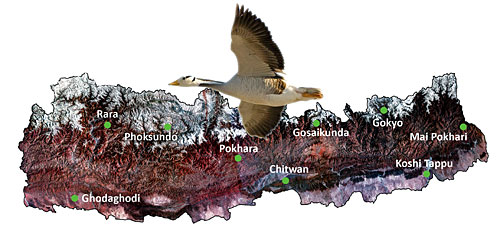 |
Nepal's wetlands are not only home to many unique species of flora and fauna but also serve as a stopover point in the routes of many migratory birds.
Flying from as far as Spain and Siberia these birds use the wetlands of Nepal to gather their energy before setting off again for India, Africa or Southeast Asia. Implemented by the Ministry of Forests and Soil, the Conservation and Sustainable use of Wetlands in Nepal (CSUWN) project aims to address these problems and raise awareness of the importance of wetlands.
Project manager Top B Khatri says, "Wetlands are important stepping stones for migratory birds, but we need to preserve them not just for birds but for the whole ecosystem."
However the destruction of wetlands due to drainage, pollution and commercial fishing has severely affected the populations of migratory birds that make places like Kosi Tappu Wildlife Reserve famous. While once nationally protected birds like the Sarus Crane was easily spotted in the wetlands, today their numbers have drastically reduced.
Most preservation institutions agree the key to saving the wetlands begins with changing the mindset of the people in power. According to Khatri, the project aims to do just that, "We are working on three major areas: coordinating various rules to make a binding policy for all. So, we are revising wetland policy to make a policy for all ministries."
Brittany Searle
Read also:
Change in the air, STUTI SHARMA
Climate change is forcing birds to alter their migration routes across the Himalaya
See also:
Bird and buffalo country, SALIL SUBEDI
Water world, SAMUEL THOMAS
A fresh new look at Nepal's fresh water, with the message: no wetlands, no water.
Birds of a feather, SRADDHA BASNYAT
Almost one-fourth of 850 bird species in Nepal are found on Shibapuri National Park.
Feathered friends, PAAVAN MATHEMA
This autumn, take time off to watch Nepal's amazingly rich bird life


